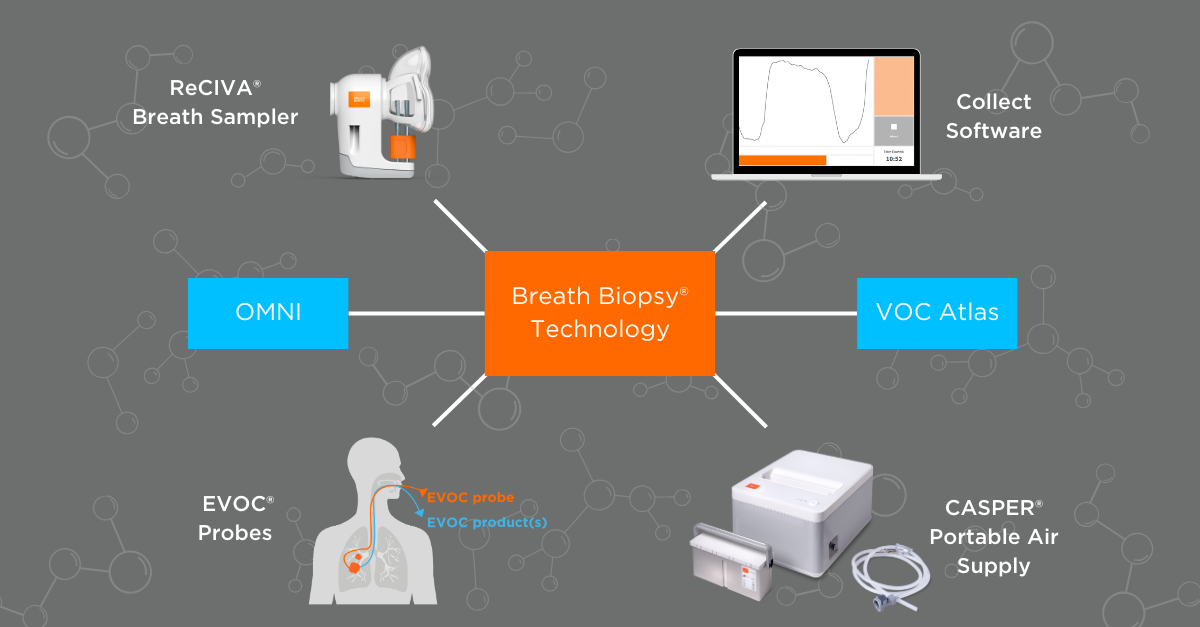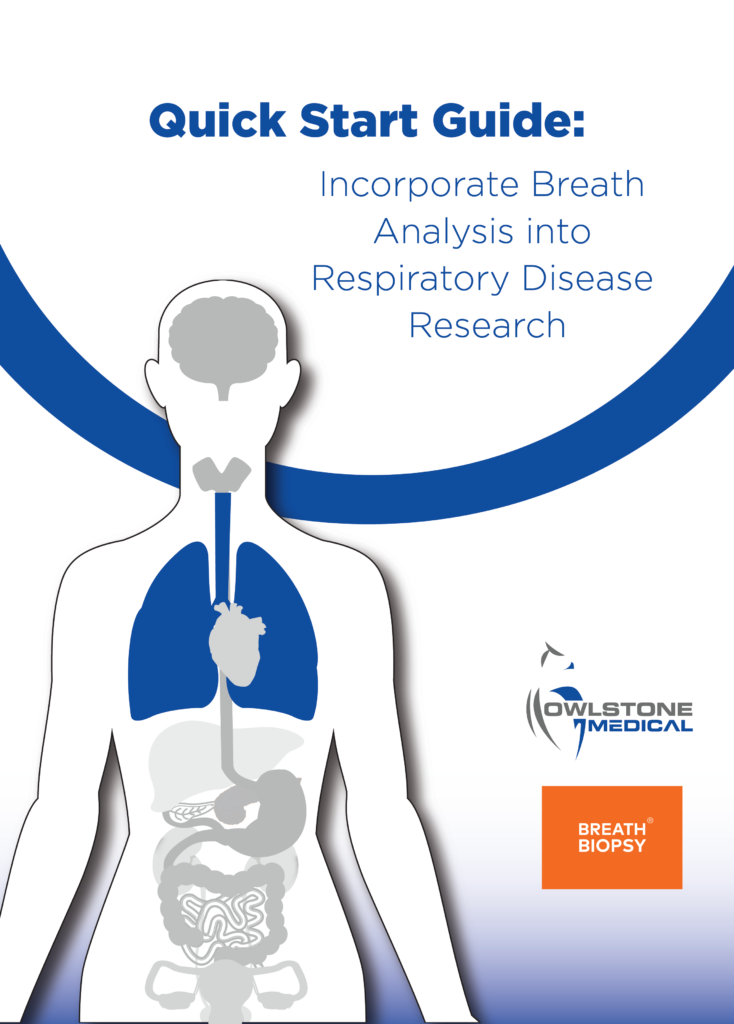Lung Cancer Associated VOCs
In 2022, it was estimated that there were around 2.5 million new lung cancer cases, which were responsible for 1.8 million deaths around the world (1), making it one of the most common types of cancer worldwide. Research suggests that early diagnosis can significantly improve prognosis, with the 5-year survival of early-stage lung cancer groups exceeding 90%, while patients with later stage lung cancer can be less than 10% (2).
Published on: 7 Oct 2024, under Blog Interviews
In 2022, it was estimated that there were around 2.5 million new lung cancer cases, which were responsible for 1.8 million deaths around the world (1), making it one of the most common types of cancer worldwide. Research suggests that early diagnosis can significantly improve prognosis, with the 5-year survival of early–stage lung cancer groups exceeding 90%, while patients with later stage lung cancer can be less than 10% (2).
Currently, radiological techniques such as Low-dose CT (LDCT) scans and Positron emission tomography (PET) or CT scans are mainly used to diagnose lung cancer. Although these techniques have high sensitivity, they have high false positive rates (23.3% for LDCT), high costs, and expose the patient to unnecessary radiation, limiting their diagnosis capabilities (2,3). Therefore, there has been great interest in finding alternative lung cancer diagnostic tests, one of which, includes the use of exhaled volatile organic compounds (VOCs).

VOCs and Lung Cancer – What’s the Connection?
VOCs are gaseous, carbon-based compounds that can be produced by the normal metabolic processes of cells. Compared to current diagnostic methods, VOCs can be collected non-invasively in the breath, are cost-effective, lack radiation exposure, and could have increased precision. These advantages have made Breath VOC analysis an attractive alternative tool to diagnose lung cancer. Due to the altered metabolism of cancer cells, tumors in the lungs can produce unique VOC profiles, which can be detected in the breath.
Studies have shown that the lung tumor microenvironment can have a distinct VOC profile, differentiating them from healthy tissue, and allowing for the use of VOCs for diagnosis. A recent meta-analysis by Fan et al. reviewed the current research landscape to assess the viability of the use of VOCs as a cost-effective, safe, and non-invasive lung cancer screening tool (3).
Overall, the results from the 25 studies investigated reinforced the use of VOCs as a screening tool for early lung cancer detection. The analysis showed that the pooled sensitivity and specificity of the included studies were 85% and 86% respectively. Looking at specific VOC chemical classes, many studies detected alkanes, alkenes, ketones, benzene, aldehydes, and alcohols in the breath of lung cancer patients.
Specifically, hexanal was the most prevalent, being detected in lung cancer patients in nearly half of the studies (3). Hexanal has been proposed as a potential biomarker, being produced from the increased oxidative stress of cell membrane phospholipids in cancer cells (4). There are also proposed mechanisms for the altered production of some of the other identified VOCs. For example, levels of ketones such as acetone are increased, likely due to the increased fatty acid metabolism in cancer, alkenes due to increased peroxidation of fatty acids and oxidative stress, and aldehydes from tumor activity and fatty acid metabolism.
Additionally, benzene levels are influenced by aromatase activity (3), and this enzyme is known to be overexpressed in breast cancer tissues (5). However, aromatase activity is yet to be determined in lung cancer and benzene could originate from the environment (3). This highlights that the altered metabolism of lung tumors can produce a detectable shift in VOC profiles in the breath.
How can the Breath Biopsy VOC Atlas® help?
However, as of yet, there have been no VOCs that have been considered as definitive biomarker for cancer. The mechanistic sources of many compounds detected in the breath are still unclear. Even though a fraction of the compounds has a known origin, they may not be cancer-specific, and many can be altered in other conditions such as infections (3). Owlstone Medical have been developing a database of VOCs present in breath which can help identify lung cancer biomarkers. The Breath Biopsy VOC Atlas® is a catalog of commonly identified VOCs in the breath, providing information on the scientific context of identified compounds.
For example, while the literature collated in the VOC Atlas agrees that studies have shown isoprene levels are altered in lung cancer patients, it also highlights that isoprene has an endogenous origin in muscle cells, and so levels can be influenced by many disease states and during muscle activity. Furthermore, it shows conflicting studies on the direction of change of the compound, making it unlikely that isoprene could serve as a useful lung cancer biomarker.
Similar information is available for the various ketones identified in the study. The database includes subjects from a variety of ages and ethnic backgrounds to account for variation across a cohort, serving as a proxy for the normal variation in the population. This makes the VOC ATLAS an extremely useful tool for the validation of potential lung cancer biomarkers by allowing the comparison to a baseline and provides a clear understanding of the origins of the compounds.
You can gain access to our VOC Atlas when it is live by signing up to our waitlist here.
Reduce Study Inconsistency with Owlstone Medical
There is inconsistency in sampling methods across breath research studies. Tedlar bags are most used to store the samples, which were prepared using different methods such as solid phase microextraction, sorption tubes, or thermal desorption methods, all of which have different effects on sensitivity and specificity. Additional differences such as detection methods and breath fraction and volume analysed have significant effects on the VOCs detected in the samples.
The lack of standardization across the different studies is a likely explanation for the low reproducibility of VOC detection across the different studies (3). Owlstone Medical have also developed the Breath Biopsy Collection Station to standardise the breath collection and analysis process. This includes the ReCIVA Breath Sampler to collect breath samples, CASPER Portable Air Supply to exclude background contaminants, and the Breath Biopsy Collect Software to ensure that the correct breath fraction is collected.
The EVOLUTION Trial
The potential for breath VOCs for lung cancer diagnosis is being explored in the EVOLUTION trial, which takes advantage of the altered metabolism of tumors. Specifically, the trial aims to measure the metabolism of an introduced VOC (EVOC) probe in the breath to indicate the expression levels of β-glucuronidase. In healthy tissue, β-glucuronidase, which breaks down the EVOC probe into D5-ethanol, is found within cells.
However, the enzyme is found at higher levels in the extracellular environment of tumors, where they can break down the EVOC Probes (6). The EVOLUTION trial measures exhaled D5-ethanol levels following EVOC Probe administration, investigating its prospects of being a reliable indicator of lung cancer. The trial is currently at phase 2 to assess the diagnostic performance of the test.
In conclusion, lung cancer is a widespread cancer responsible for many deaths around the world. There is currently an unmet need for alternative screening methods for the early detection of the disease, and the analysis of breath VOCs as biomarkers is emerging as a promising option. The Breath Biopsy VOC ATLAS is a biomarker platform that could streamline the biomarker identification process by providing valuable information about candidate VOC biomarkers. Additionally, recent developments in breath analysis technology allow for more robust breath analysis and standardization across different studies to accelerate biomarker identification.
In upcoming months, we will be making specific Atlas data/functionality accessible, through our new partnership with the Bill & Melinda Gates Foundation. Register your interest to be notified of further updates here. To find out more information about breath biomarkers for lung cancer, and other potential research studied involving the use of VOCs, please do not hesitate to contact us.
References
- Lung cancer statistics | World Cancer Research Fund International [Internet]. WCRF International. [cited 2024 Aug 28]. Available from: https://www.wcrf.org/cancer-trends/lung-cancer-statistics/
- Ning J, Ge T, Jiang M, Jia K, Wang L, Li W, et al. Early diagnosis of lung cancer: which is the optimal choice? Aging. 2021 Feb 11;13(4):6214–27. doi: 10.18632/aging.202504
- Fan X, Zhong R, Liang H, Zhong Q, Huang H, He J, et al. Exhaled VOC detection in lung cancer screening: a comprehensive meta-analysis. BMC Cancer. 2024 Jun 27;24(1):775. doi: 10.1186/s12885-024-12537-7
- Mousazadeh M, Jahangiri-Manesh A, Nikkhah M, Abbasian S, Moshaii A, Masroor MJ, et al. Detection of hexanal gas as a volatile organic compound cancer biomarker using a nanocomposite of gold nanoparticles and selective polymers. J Electroanal Chem. 2022 Jan 15;905:115962. doi: 10.1016/j.jelechem.2021.115962
- Chen S. Aromatase and breast cancer. Front Biosci-Landmark. 1998 Aug 6;3(4):922–33. doi: 10.2741/A333
- Juan TY, Roffler SR, Hou HS, Huang SM, Chen KC, Leu YL, et al. Antiangiogenesis Targeting Tumor Microenvironment Synergizes Glucuronide Prodrug Antitumor Activity. Clin Cancer Res. 2009 Jul 15;15(14):4600–11. doi: 10.1158/1078-0432.CCR-09-0090


